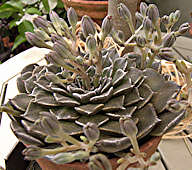Graptopetalum Rose 1911
Graptopetalum is a genus of 15 species of small perennial rosetted succulents with fleshy, smooth leaves varying in colour from silvery-gray or pink to waxy green and their surface may be speckled. In many species the petals are also speckled. (Graptopetalum = engraved petals) The stamens characteristically curve outwards between the petals when the stigmas become receptive, presumably to avoid self-pollination.
These plants are found growing in rocky mountains of Southern Arizona into central Mexico. Graptopetalum is related to Sedum.
Tacitus Moran & Meyrán 1974
The obsolete monotypic genus Tacitus (for T. bellus) has been incorporated recently into Graptopetalum (as G. bellum) but Tacitus may well be seen on labels.
|
 |
Graptopetalum amethystinum Walther 1931 (Lavendar Pebbles) Syn. Pachyphytum amethystinum
The prostrate brownish stems carry a rosette of rounded but flattened purple-brown leaves with a powdery white coating. The branching flower stem carries clusters of flowers with five rounded gray-green sepals, five lanceolate red petals with a basal grey-green band spotted with red and a grey-green outer surface. Stamens are lemon yellow.
Native to mountains in the Mexican states of Durango, Jalisco and Sinaloa where the branching stems hang down steep cliffs. New plants can be propagated from stem or leaf cuttings.
|
 |
Graptopetalum bellum Hunt 1979 Syn. Tacitus Bellus Moran & Meyrán 1974
The rosette of thickened obovate grey-green leaves produces a branching thyrse with large deep-pink flowers.
Known from a single rocky location at an elevation of 5200ft in the mountains of the Mexican state of Chihuahua.
Probably the most widely propagated Graptopetalum in the horticultural trade. This choice plant is very sensitive to damp and needs very careful watering from below, and no water at all during cold weather.
|


|
Graptopetalum pachyphyllum Rose 1922
This species has small rosettes of thickened, ovate glaucous blue leaves on sprawling stems. One of only two Summer flowering species. The inflorescence is a cluster of flowers with 5 pointed yellow petals marked with red dots, on a long leaf-bearing flowering stem.
Native to mountains at up to 7500ft in the Mexican states of Hildago, Jalisco, Querétaro, San Luis Potosí and Zacatecas.
|
 |
Graptopetalum paraguayense Walther 1938 (Ghost Plant)
This species has rosettes of thickened, ovate purplish-grey leaves on thick, sprawling stems. Leaves fall off readily and may be used to propagate new plants.
Small clusters of white flowers, with tiny red spots, are produced in the Spring.
Known from a single locality up to 2500ft in the Mexican mountains and moderately hardy. The leaves are edible and used in Taiwan traditional medicine to regulate blood pressure.
|






 Families of Succulent Plants
Families of Succulent Plants Crassulaceae
Crassulaceae 



